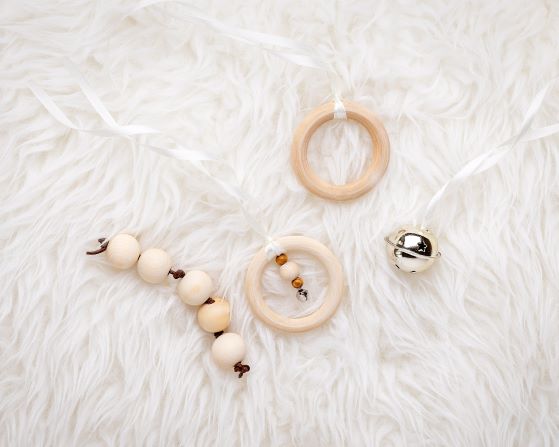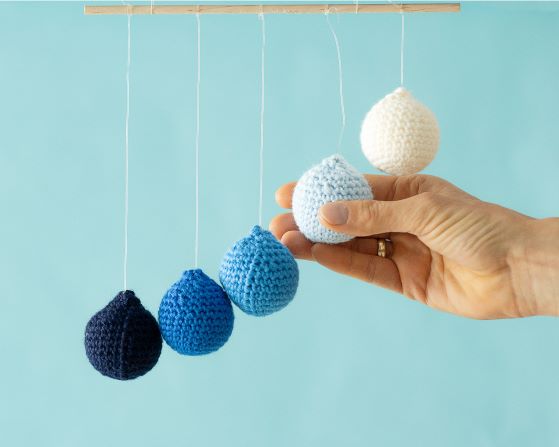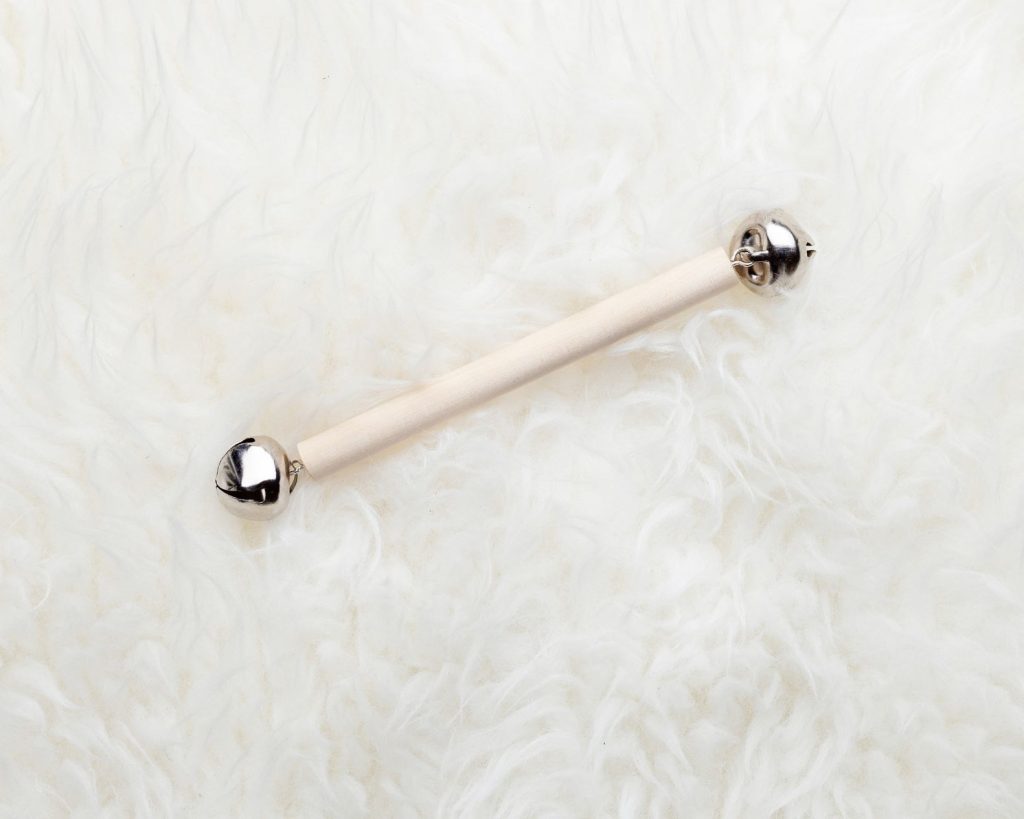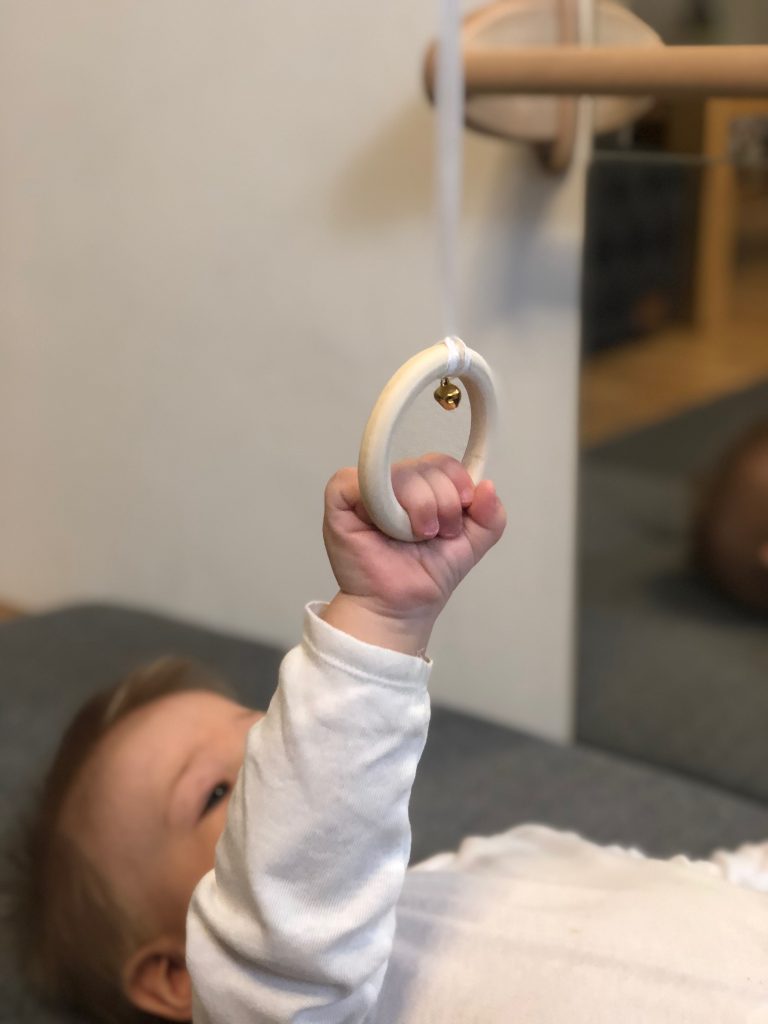What comes after the Montessori Visual Mobiles? Do babies have to wait to continue their Montessori education until they get to go to preschool? Of course not! There’s a whole world out there for babies whose visual sense has fully developed and are ready for a new challenge. This is the world of the Montessori Tactile Mobiles! Unlike the visual materials, that were only meant to be watched but not to be touched, these are all about exploration and manipulation with tiny baby hands. Read on about all the different types and their benefits for little ones.

WHAT ARE TACTILE MOBILES FOR?
You might have noticed that, while observing the Montessori visual mobiles, your baby has started to reach toward the elements and trying to catch them. Batting very often starts with the colourful balls of Gobbi mobile, for example. It is very important that we keep the visual mobiles out of reach, your little one should not touch them!
This is where the tactile mobiles come in. They ARE meant to be touched, batted, grasped, pulled and manipulated in every way possible! As a result, they may make a lovely jingling sound (Bell on a Ribbon, Montessori Bell Rattle), they are interesting to touch (Crocheted Gobbi mobile (photo below), Grasping Beads, Montessori Puzzle Ball), or can be tasted (Ring on a Ribbon). The mobiles are open-ended, exploratory, discovery Montessori materials which engages all your little one’s senses. This experience is immensely enjoyable for a baby who is ready to understand more of the world.

WHY ARE THERE SO MANY TYPES OF MOBILES?
Every Montessori mobile has an age-appropriate purpose, which is to provide smooth, continuous stimulation for your baby’s developmental needs. This stimulation is just the right amount, to offer a challenge but at the same time avoid overwhelming your little one’s senses. As a result, as your baby grows, the mobiles change to adapt to the particular needs of that developmental phase. If you follow the suggested mobile sequence, you can make sure that your baby will possess the whole compass of skills they can offer.
Of course, every baby is different. Some of them develop faster in one developmental area and others in other areas. It is your job to observe your little one’s progress. You don’t have to rush out and buy every single Montessori mobile! Use the ones that you deem necessary or that your baby is interested in. Luckily, they are all very simple and easy to DIY and this is especially true of the Montessori Tactile Mobiles!
WHY DO BABIES FIND THE MONTESSORI TACTILE MOBILES SO INTRIGUING?
At first your baby will probably just stare at the mobile, or not even notice it. (That’s the reason why the Bell on a Ribbon is so shiny, to capture attention.) It’s very likely that s/he will not know what to do with it! Then, a ‘happy accident’ happens, when accidentally s/he touches it. (The bell makes a lovely sound.) This first moment of interaction is the most important, it will probably blow your little one’s mind!!
With this experience comes the realisation that your baby can interact and have control over the environment, which has huge repercussions in the near future. The whole world will change around that tiny baby! From making random, involuntary movements here and there s/he’ll soon move with purpose and will start batting, grabbing, pulling, discovering hands, passing objects from one hand to another…. If a baby has enough time and the opportunity, from here on s/he’ll progress in huge leaps. If you have a chance, be there and observe your baby closely, not to lose these crucial moments!

WHAT ARE THE DEVELOPMENTAL BENEFITS OF THE TACTILE MOBILES?
Apart from all the above? They have enormous benefits in all learning areas. Let’s have a look and emphasise a few of these.
Cognitive development
The more your baby has the chance to ‘work’ with the mobiles, the more her/his concentration and focus lengthens. It is very important that as much as possible, we don’t interrupt this intense work. Your little one will let you know when s/he’s had enough of the activity by turning away, making distressed noises or sounds s/he uses to call you.
Montessori tactile mobiles offer an activity which is very open-ended, and where your baby uses all their senses to explore the material. You don’t need to demonstrate what to do. S/he will discover it alone and the way the interaction will go depends fully on your little one’s creativity.
Language development
It always makes me smile to see how some babies develop a ‘relationship’ with their mobiles. They talk and sing to them, babbling away to them while working, just like an older child would hum while colouring in. You just have to sit back and listen to the gentle sound of the bell and the happy baby noises that follow it.

Social development
Your little one will very likely want to involve you as well at some point. They might look straight at you when they manage to do something they have been working to do. They might ‘explain’ to you what they are doing, looking into your eyes. In a Montessori environment we don’t give a lot of loud praise (more about this later). Instead, just be there for your baby, catch these moments and share them with her/him.
Physical development
Your baby’s robotic arm-lifts will soon become more graceful, progressing from unintentional to intentional, controlled movements. S/he practices hand-eye coordination, gross – and fine motor skills, strengthens core muscles… it’s a whole body workout!
Emotional development
After making that first connection with the material, your baby will then want to try to repeat it. This is hard work for somebody who can’t even control their movements! First the motions might look slightly robotic or disorganized. But don’t worry, this is where the real work happens! From the involuntary ‘accidents’ your baby will do everything to make their motions voluntary and make the same reaction again. And when it happens, the sense of achievement it gives will be a huge step towards raising your little one’s self-esteem!

And if you wonder about the differences between simple, natural Montessori materials and the modern, high-tech baby toys, head over to this post.
HOW TO USE TACTILE MOBILES?
Lower the mobiles so your baby can easily reach them. If you’d like your little one to be able to mouth them, such as the Ring on a ribbon, then make sure s/he can easily do it. Please always check the material before use. Make sure that the ribbons are tightly attached and the mobile won’t fall apart. Sometimes babies can be very strong!
Always supervise your baby when using a mobile to avoid accidents happening. Follow up on the cues your baby gives you (changes in behaviour, noises.)
Some of the mobiles are great to use with feet as well, such as the Bell on a ribbon or the Montessori Puzzle Ball. Give it a try!
Try to use them during tummy time, too, but lower them sufficiently so your baby can visually observe them as well.
FINAL THOUGHTS
The Montessori tactile mobiles are the perfect way to seamlessly follow your baby’s developmental progress from visual to physical. Although the above mentioned mobiles are all under the umbrella of Montessori materials, you don’t have to buy all of them. There are many other tactile materials you can use which you can find around the house. With a little research on the internet you’ll find that the possibilities are endless!
Tactile mobiles are very easy to DIY, you might even have everything you need in your house! If you’d like to buy all the resources for them in one place, take a look at my Shop. There you can find the Basic Tactile set or the DIY High-Contrast Tactile Set, which contains the Grasping Beads as well.
Click here to read more about how the Montessori Visual Mobiles or the Sensory Baby Toys help your baby’s development.
How did your baby react to this mobile? Please share your photos on my Instagram site. #montessoriedited, @montessoriedited
